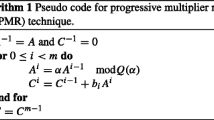Abstract
This paper presents design details for a bit-level systolic cell that has been recently introduced for imple menting digital signal processing (DSP) operations over finite rings.
This paper concentrates on the efficient construction of the basic cell, using a 3µ p-well CMOS technology. The design uses a 5-bit, 32-word dynamic ROM as the main computational element, and details of all elements of the cell are discussed with regard to minimizing the (Area. Period) product. The final cell design and simulation details are compared with a pipelined gated full-adder, designed in the same technology, which represents the most common type of binary bit-level systolic cell.
It is shown that the (Area. Period) product of the binary cell is 68% greater than that of the finite ring cell, but the power of the finite ring cell, in implementing fixed coefficient inner product multiplications, is much greater than that of the binary cell. There are also advantages associated with the reduction of the connectivity across the dynamic range, including clock-skew reduction, ease of testing, and fault detection. The conclusion is that in certain classes of DSP operations, this new cell can offer more than an order of magnitude improvement in (Area.Period) product of complete bit-level systolic arrays, over its binary counterpart.
Similar content being viewed by others
7. References
P.R. Capello, and K. Steiglitz. Digital signal processing applications of systolic algorithms. InVLSI Systems and Computations, H.T. Kung, R. Sproull and G. Steele eds., Computer Science Press, 1981, pp. 245–254.
J.V. McCanny, and J.G. McWhirter. Implementation of signal processing functions using 1-bit systolic arrays.Electronics Letters, Vol. 18, No. 6, March 1982, pp. 241.
A. Corry, and K. Patel. Architecture of a CMOS correlator.Int. Conf on Circuits and Systems, 1983, pp. 522–525.
J.V. McCanny and J.G. McWhirter. Bit-level systolic array circuit for matrix vector multiplication.IEE Proceedings, Vol. 130, Pt. G, No. 4, August 1983, pp. 125–130.
J.V. McCanny and J.G. McWhirter. Optimized bit level systolic array for convolution.IEE Proceedings, Vol. 131, Pt. G, No. 6, October 1984, pp. 632–637.
K. Iwano, and K. Steiglitz. Some experiments in leaf-cell optimization. InVLSI Signal Processing, IEEE Press, 1985, pp. 387–395.
M. Hatamian, and G.L. Cash. High speed signal processing, pipelining, and signal processing.Int. Conf. on Acoustics, Speech, and Signal Processing, April 1986, pp. 1173–1176.
S. Y. Kung and J. Annevelink. VLSI design for massively parallel signal processors.Microprocessors and Microsystems, Vol. 7, No. 10, December 1983, pp. 461–467.
S.C. Knowles, R.E Woods, J.G. McWhirter, and J.V. McCanny. Bit-level systolic arrays for IIR filtering.International Conference on Systolic Arrays, San Diego, May 1988, pp. 653–663.
S. Bandyopadhyay, G.A. Jullien, and M. Bayoumi. Systolic arrays over finite rings with applications to digital signal processing. InSystolic Arrays, edited by W. Moore, A. McCabe, and R. Urquhart, Adam Hilger, Bristol, 1986.
M.A. Bayoumi, G.A. Jullien, and W.C. Miller. Bit-Parallel based filters using residue number systems.27th Midwest Symposium on Circuits and Systems, June 1984.
N.S. Szabo and R.I. Tanaka.Residue Arithmetic and its Applications to Computer Technology. McGraw-Hill, New York, 1967.
H.T. Kung. Why systolic architectures.IEEE Computer Magazine, Vol. 15, No. 1, January 1982, pp. 37–46.
D.I. Moldovan. On the design of algorithms for VLSI systolic arrays.Proc. of IEEE, Vol. 71, No. 1, January 1983, pp. 113–120.
M. Taheri, G.A. Jullien, and W.C. Miller. High speed signal processing using systolic arrays over finite rings.IEEE Trans. on Selected Areas in Communications, VLSI in Communications III, Vol. 6, No. 3, April 1988, pp. 504–512.
J.V. McCanny, R.A. Evans, and J.G. McWhirter. Use of unidirectional data flow in bit level systolic array chips.Electronics letters, Vol. 22, No. 10, May 1986, pp. 540–541.
G.A. Jullien and W.C. Miller. The design of 1-bit systolic cells and arrays for high speed computational throughput. In preparation, 1988.
L.R. Rabiner and B. Gold.Theory and Application of Digital Signal Processing. Prentice-Hall, Englewood Cliffs, N.J., 1975.
A. Peled and B. Liu. A new hardware realization of digital filters.IEEE Trans. on Acoustic, Speech, and Signal Processing, Vol. ASSP-22, No. 6, December 1974, pp. 456–462.
M. Taheri.VLSI Fault-Tolerant Systolic Architectures. Ph.D. dissertation, University of Windsor, April 1988.
G.A. Jullien, M. Taheri, and W.C. Miller. A low-overhead scheme for testing a bit level finite ring systolic array. Submitted for publication,Journal of VLSI Signal Processing, 1988.
M. Taheri, G.A. Jullien, and W.C. Miller. Fault detection in distributed RNS processing.IEEE Inter. Conf. on Computer Design: VLSI in Computers & Processors, October 1987, pp. 302–305.
Author information
Authors and Affiliations
Rights and permissions
About this article
Cite this article
Jullien, G.A., Bird, P.D., Carr, J.T. et al. An efficient bit-level systolic cell design for finite ring digital signal processing applications. J VLSI Sign Process Syst Sign Image Video Technol 1, 189–207 (1989). https://doi.org/10.1007/BF02427794
Received:
Revised:
Published:
Issue Date:
DOI: https://doi.org/10.1007/BF02427794




